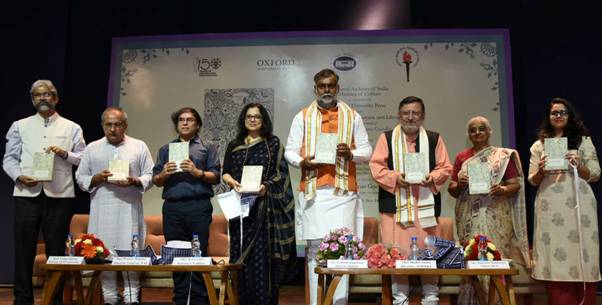Union Minister of State (Independent Charge) for Culture and Tourism Shri Prahlad Singh Patel launches the book ‘the Diary of Manu Gandhi’
Union Minister of State (Independent Charge) for Culture and Tourism, Shri Prahlad Singh Patel launched the book ‘the Diary of Manu Gandhi’ (1943-44) at a function in the auditorium of Nehru Memorial Museum and Library today in New Delhi. The book has been brought out by National Archives of India, on the occasion of 150th anniversary of Mahatma Gandhi in collaboration with Oxford University Press.

Speaking on the occasion Shri Prahlad Singh Patel said that the art of diary writing is height of self discipline of an individual and habit of diary writing converts an ordinary man into extraordinary man. The Minister appreciated efforts of National Archives of India, Dr Tridip Suhrud and Oxford University Press for English translation of the Diary of Manu Gandhi. He said that this translation will help entire world to understand life of Mahatma Gandhi through the Diary of Manu Gandhi. He also urged NIA to translate the Diary of Manu Gandhi into other Indian languages with the help of Sahitya Academy so that the beauty of this book may spread all over the country.
The Diary of Manu Gandhi originally in Gujarati has been edited and translated by Dr Tridip Suhrud, a well known scholar engaged in understanding the Gandhian Intellectual tradition. The first volume covers the period 1943-1944. Manu Gandhi (Mridula) was a grand niece of Mahatma Gandhi, daughter of his Nephew Jaisukhlal Amritlal Gandhi, and stayed with Gandhiji till his assassination. She was an aide to Kasturba Gandhi during her imprisonment in the Aga Khan Palace in 1943.
The first volume of the diary is a record of her life and times with Mahatma Gandhi between 1943-44. Authenticated by Gandhiji himself, the meticulous and intimate entries in the Diary throws light on his life as a prisoner and his endeavour to establish the possibility of collective non-violence. It further chronicles the spiritual and educational pursuits of a woman who takes up writing as a mode of self examination. She shares a moving portrait of Kasturba Gandhi’s illness and death. The author also expresses the deep emotional bond she had developed with Gandhiji.
The National Archives of India is an Attached Office under the Ministry of Culture. It was established on 11 March 1891 at Kolkata(Calcutta) as the Imperial Record Department. Following the transfer of the capital from Calcutta to Delhi in 1911, the present building of the National Archives of India was constructed in 1926 which was designed by Sir Edwin Lutyens. The transfer of all records from Calcutta to New Delhi was completed in 1937.
This publication will immensely benefit the scholars interested in Gandhian studies and history of modern India at large. The book will be another milestone added to the publications that have been brought out by National Archives of India from time to time.
The Department intends to bring out publications out of rich reservoir of both public and private papers collection in order to continue this process.
*****
NB/AKJ